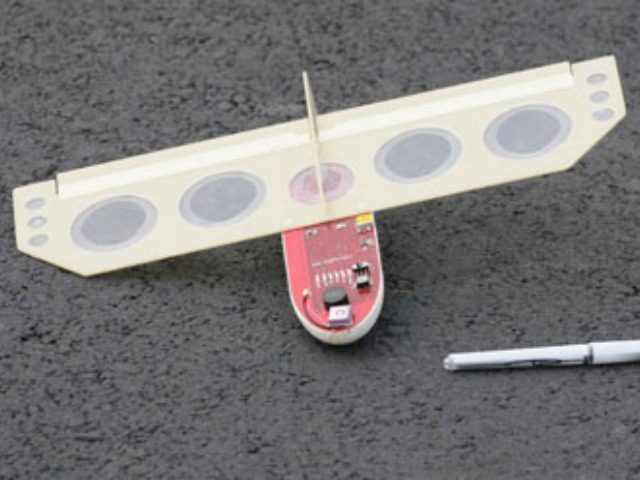The U.S. Naval Research Laboratory will test “palm-sized” CICADA surveillance drones by dropping them from an airplane, according to recent reports.
“The CICADA, or Close-In Covert Autonomous Disposable Aircraft, have pressure, temperature and humidity sensors on board, and consist basically of a circuit board with tiny wings and autopilot controls built-in,” explained Tech Crunch on Monday. “It weighs only 65 grams, and drops at around 1,000 feet per minute according to the official specs.”
“One of the launch tubes that carry the CICADAs holds 32 individual drones, and the tube is designed to be dropped from a U.S. Navy P-3 Orion airplane,” they continued. “The CICADAs deploy from the tube once it’s released from the aircraft, and fly on to their target, where they can land with accuracy of around 5 meters square.”
The CICADA drones, which have been in development since 2006, have been described as “palm-sized covert surveillance devices,” which work with “flexibility, speed, and silent operation.”
They received their first test flight in 2011, and according to IHS Jane’s International Defense Review, the system has now been approved for deployment.
“The launch system has now been approved by the US Naval Air Systems Command for deployment from a P-3 Orion maritime surveillance aircraft,” reported Jane’s Geoff Fein last week. “With the basic research effort complete, the CICADA program is hoping to transition the technology to industry or a military sponsor who could tailor it for a specific mission.”
“To date, NRL has delivered 150 CICADAs to the NASA Langley Research Center,” he added.
According to their website:
The U.S. Naval Research Laboratory provides the advanced scientific capabilities required to bolster our country’s position of global naval leadership. The Laboratory, with a total complement of approximately 2,500 personnel, is located in southwest Washington, D.C., with other major sites at the Stennis Space Center, Miss., and Monterey, Calif. NRL has served the Navy and the nation for over 90 years and continues to advance research further than you can imagine.
In March, the commander of the U.S. Strategic Command warned that “unauthorized intrusions” from non-government drones over nuclear facilities posed a “growing threat” to national security, while in November, it was revealed that “DroneGun,” a new product from company DroneShield, would allow users to take down drones by scrambling and cutting off the machine’s electronic communications and returning it either to the “offending party” or a safe area.
Charlie Nash is a reporter for Breitbart Tech. You can follow him on Twitter @MrNashington or like his page at Facebook.

COMMENTS
Please let us know if you're having issues with commenting.